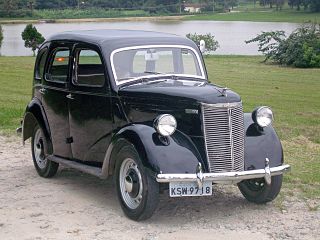
The Ford Prefect is a line of British cars which was produced by Ford UK between 1938 and 1961 as an upmarket version of the Ford Popular and Ford Anglia small family cars. It was introduced in October 1938 and remained in production until 1941. Returning to the market in 1945, it was offered until 1961. The car progressed in 1953 from its original perpendicular or "sit-up-and-beg" style to a more modern three-box structure. Some versions were also built and sold by Ford Australia.

The Ford Popular, often called the Ford Pop, is a car from Ford UK that was built in England between 1953 and 1962. When launched, it was Britain's lowest priced car.

The Triumph Spitfire is a British sports car manufactured over five production iterations between 1962 and 1980. Styled for Standard-Triumph in 1957 by Italian designer Giovanni Michelotti, the Spitfire was introduced at the London Motor Show in 1962. It was manufactured at the Standard-Triumph Canley works, with approximately 315,000 produced over 18 years.

The Ford Squire is a car that was produced by Ford UK from 1955 to 1959.
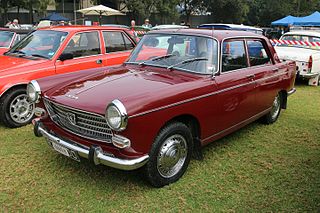
The Peugeot 404 is a large family car produced by French automobile manufacturer Peugeot from 1960 to 1975. A truck body style variant was marketed until 1988. Styled by Pininfarina, the 404 was offered initially as a saloon, estate, and pickup. A convertible was added in 1962, and a coupé in 1963. The 404 was fitted with a 1.6 litre petrol engine, with either a Solex carburetor or Kugelfischer mechanical fuel injection or a 1.9 litre diesel engine available as options. Introduced at the Paris Motor Show as an option was the inclusion of a 3-speed ZF automatic transmission, similar to the unit already offered on certain BMW models, as an alternative to the standard column-mounted manual unit.
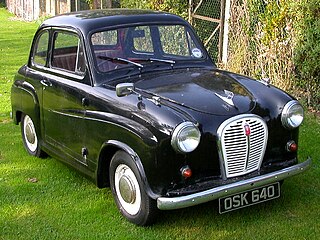
The Austin A35 is a small family car that was sold by Austin from 1956 until 1968. About 280,897 A35s of all types were produced.

The Austin A40 Farina is a small, economy car introduced by Austin in saloon (1958) and A40 Countryman (1959) estate versions. It has a two-box body configuration. It was badged, like many before it, as an A40, consistent with Austin's naming scheme at the time, based on the approximate engine output in horsepower; and to distinguish it from other A40 models, it was also given a suffix name – this one being the Farina, reflecting the all-new design by Italian Battista Farina's Pinin Farina Turin studio.

The Austin A40 Somerset is a motor car which was produced by the Austin Motor Company from 1952 until 1954. The Somerset replaced the Austin A40 Devon and, as a body-on-frame car, it was comparable in size to its predecessor. It shared a number of components with the Devon which included a similar 1.2 litre straight-4 pushrod engine. The Somerset's engine was updated to produce 42 hp (31 kW), compared to the Devon's 40 hp (30 kW), giving the car a top speed of 70 mph (110 km/h).

The Austin Cambridge is a medium-sized motor car range produced by the Austin Motor Company, in several generations, from September 1954 through to 1971 as cars and to 1973 as light commercials. It replaced the A40 Somerset and was entirely new, with modern unibody construction. The range had two basic body styles with the A40, A50, and early A55 using a traditional rounded shape and later A55 Mark IIs and A60s using Pininfarina styling.

The Vauxhall Cresta is a British automobile which was produced by Vauxhall from 1954 to 1972. The Cresta was introduced in 1954 as an upmarket version of the Vauxhall Velox, itself a six-cylinder version of the Vauxhall Wyvern. The Cresta models were the E (1954–1957), PA (1957–1962), PB (1962–1965) and PC (1965–1972). The Viscount (1966–1972) was an upmarket Cresta PC.

The Rover P4 series is a group of mid-size luxury saloon cars produced by the Rover Company from 1949 until 1964. They were designed by Gordon Bashford.
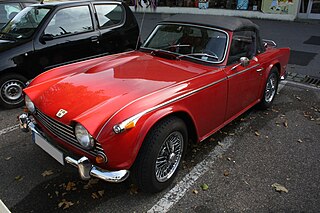
The Triumph TR5 is a sports car built by the Triumph Motor Company in Coventry, England, between August 1967 and September 1968.

Turner Sports Car Company Limited was a 1950s British sports car manufacturer, that closed in 1966.

The Mark I Mini (1959–1967) was the first version of British Motor Corporation's Mini model. It is characterised by its sliding windows, external door hinges and "moustache" grille. In the United Kingdom the Mark I was produced between 1959 and 1967 at the Longbridge Plant near BMC's headquarters, with production in Australia continuing until 1970. The Mini Mark I was sold under both Austin and Morris marque names.
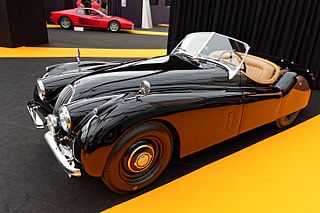
The Jaguar XK120 is a sports car manufactured by Jaguar between 1948 and 1954. It was Jaguar's first sports car since SS 100 production ended in 1939.

The Mazdaspeed3 is a sport compact hatchback introduced for the 2007 model year by Mazdaspeed and produced until 2013. The Mazdaspeed3 is a performance-enhanced version of the 5-door Mazda3.
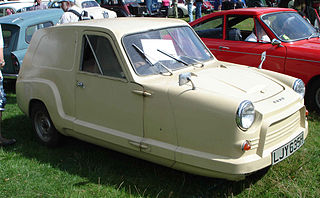
The Bond 875 is a small three-wheeled car partly designed by Lawrence "Lawrie" Bond and manufactured by Bond Cars Ltd in Preston, United Kingdom, from 1965 to 1970. There was also a van version from 1967, known as the Ranger.

The Standard Vanguard is a car which was produced by the Standard Motor Company in Coventry, England, from 1947 until 1963.
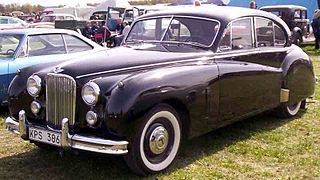
The Jaguar Mark VII is a four-door luxury car produced by Jaguar Cars of Coventry from 1951 to 1956. Launched at the 1950 British International Motor Show as the successor to the Jaguar Mark V, it was called the Mark VII because there was already a Bentley Mark VI on the market. A version of the Jaguar Mark V with the XK engine had been designated as the Mark VI, but it is thought that only two were built.

The Alvis Three LitreTA 21, is an automobile which was produced by Alvis Cars between 1950 and 1953. It was announced to the British public the day it went on display at the opening of the Geneva Motor Show 16 March 1950.


























